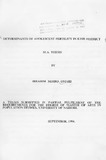| dc.description.abstract | This study undertakes to examine adolescent fertility in Kisii district. Its major objectives are geared towards the factors that determine adolescent fertility. The study was based on eight clusters sampled using NASSEP III which was adopted by KDHS of 1993. NASSEP III stratifies the country into rural and urban. For the case of Kisii district seven out of 36 rural clusters were sampled for study while one out of four urban clusters was sampled for study. Systematic sampling was used by the interviewers .in which they moved from one household to another to interview the suitable respondents. A total of 500 adolescents were interviewed whereby 283 were girls and 217 were boys. Only girls have been used for in depth analysis. The factors that affect adolescent fertility were investigated through socio-cultural, demographic variables. The socio-cultural factors that were considered included: Socio-economic and family type and religion while the socio-economic factors included education of adolescent, education of mother, education of father, occupation of adolescent, occupation of mother and occupation of father. The demographic factors included adolescent marital status, parent's marital status, age at marriage, age at first birth, age at menarche, age at first sexual intercourse, frequency of sexual intercourse, knowledge of contraceptives and use of contraceptives. The data collected was analyzed using Cross-tabulation and iv Chi-square, Correlation and Multiple regression analysis. The study found out that adolescent fertility is a consequence of the interaction of multiple factors mentioned above. Cross-tabulation and chi-square analysis revealed that most of the factors under consideration were statistically significant. The multiple regression result based on the categorical variables explains 42.3 percent variance in adolescent fertility while result based on continuous variables explains 17.6 percent variance. The study gives some recommendations to be adopted in the face of the increase of adolescent fertility in the district which includes among others compulsory and affordable education, legalization of abortion as a method of birth control and the need to put in place adolescent programmes such as counselling services and child care training. | en |

